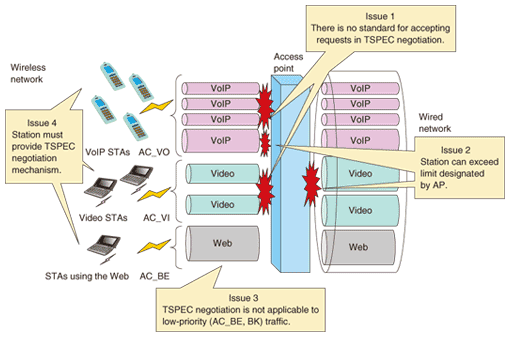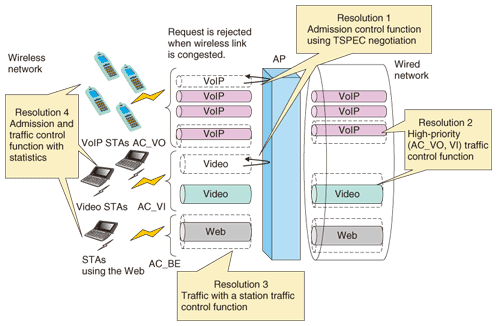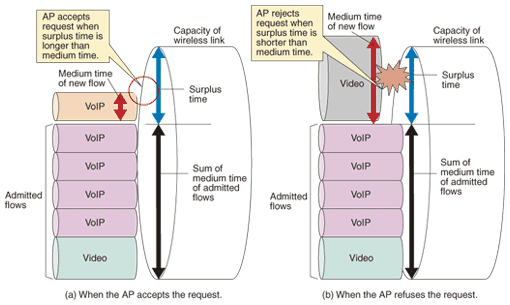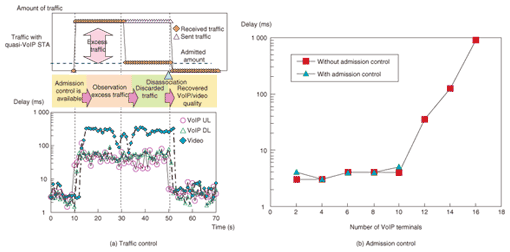 |
|||||||
|
|
|||||||
Vol. 5, No. 11, pp. 44–48, Nov. 2007. https://doi.org/10.53829/ntr200711sf7 Admission and Traffic Control Techniques for WLANsAbstractWe describe admission and traffic control techniques that improve the quality of service (QoS) of VoIP (voice over Internet protocol) and video applications in wireless local area networks (WLANs).
1. IntroductionThe quality of realtime applications, such as VoIP (voice over Internet protocol) and video streaming, over wireless local area networks (WLANs) often becomes worse because wireless links are unstable.Therefore, mechanisms to support the quality of service (QoS) of realtime applications over WLANs are needed. In this article, we describe admission and traffic control techniques that can improve VoIP and video quality in WLANs. 2. Techniques for QoS support on WLANsThe enhanced distributed channel access (EDCA) mechanism in the IEEE802.11e standard can support multiple priorities for applications over WLANs. Access points (APs) and stations (STAs) can communicate with each other using the four priorities supported by the EDCA mechanism. Realtime applications require a higher priority than non-realtime applications, so the communication quality must be better for realtime applications than for non-realtime ones. Although EDCA can support several priorities, it cannot guarantee good quality communication. Heavy traffic over a wireless link or the communication of a lot of data degrades the communication quality of realtime applications such as VoIP or video. If the wireless link is congested, new requests for communication should be rejected to protect the quality of communication that has already begun. The TSPEC (traffic specifications) negotiation procedure defined in the IEEE802.11e standard is shown in Fig. 1. First, the station asks the AP for its QoS requirements, such as mean data rate, packet length, and physical rate via an add traffic stream (ADDTS) request, when admission control is mandatory at that priority in the beacon. The AP decides whether the request is acceptable or not and transmits its decision to the station. The station can start high-priority communication only when it is permitted to do so by the AP. The station also sends a delete traffic stream (DELTS) message when it has finished communicating.
TSPEC negotiation can prevent the wireless link from becoming congested and can keep the communication quality good. Stations then know that congestion has occurred in the wireless link before they start communicating and can wait to connect. This enables stations to use realtime applications such as VoIP and video comfortably. 3. Issues of TSPEC negotiationTSPEC negotiation is very useful for QoS support, but there are four technical issues, which are illustrated in Fig. 2. First, TSPEC negotiation has no standard for accepting requests. Second, stations can exceed the limit designated by APs because they have the right of autonomous access. Third, TSPEC negotiation is not applicable to low-priority traffic (AC_BE, BK), so low-priority traffic must be controlled to avoid crowding high-priority traffic. Fourth, the station must provide the TSPEC negotiation mechanism; otherwise, communication is not protected in this framework. Our techniques for resolving these issues are described in section 4.
4. Developed techniquesWe developed admission and traffic control techniques to support QoS. These techniques are described below and illustrated in Fig. 3.
4.1 Admission control function using TSPEC negotiationThe way requests are assigned priority at the AP is shown in Fig. 4. The AP uses the surplus time to decide whether or not to accept the request. The surplus time is calculated from the parameters in TSPEC that have already been accepted. The AP compares the surplus time and the medium time, which is calculated from the TSPEC that has just been received. If the surplus time is longer than the medium time (Fig. 4(a)), the AP accepts the request. If it is shorter, the AC rejects it (Fig. 4(b)). This function can maintain the quality of the communication because it prevents excess communication in a wireless link.
4.2 High-priority (AC_VO, VI) traffic control functionIf the AP finds traffic in excess of the admitted amount, it controls it using the mechanism illustrated in Fig. 5. First, it discards the excess traffic. Moreover, it sends a disassociation message to a station that constantly sends excessive traffic. If the traffic does not exceed the admitted amount, the AP switches to the observation phase. This function can maintain good quality communication because it can control traffic in excess of the admitted traffic.
4.3 Station traffic control functionThe AP controls the traffic to and from a station. If it observes traffic in excess of the limit, the AP controls this station°«s traffic using the same high-priority control function shown in Fig. 5. 4.4 Admission and traffic control function with statisticsThis function is applicable to stations that do not support TSPEC negotiation. In this function, the access point uses the association request/response sequence instead of the TSPEC negotiation and makes acceptance decisions based on statistics instead of on the surplus time in the TSPEC negotiation. The AP has two functions: an admission control function using statistics (surplus bandwidth and VoIP retry count) to admit a VoIP request and a traffic control function that enables the AP to control traffic other than VoIP when the wireless link is continuously congested. These functions make it possible for stations that do not support TSPEC negotiation to be admitted to the wireless links. 5. Effects of the developed functionsWe performed experiments to determine the effects of these functions. The effects of the high-priority traffic control functions described in Fig. 5 are shown in Fig. 6(a). The APs and STAs used IEEE802.11b. VoIP stations with two-way communications (64 kbit/s) and a video station with a downlink (2 Mbit/s) were admitted. Figure 6(a) shows the delays for the uplink (UL) and downlink (DL) of these STAs when a lot of traffic was sent from an admitted quasi-VoIP station. The VoIP and video delay were very low, 0 to 10 s, because the admission control function distributed the wireless resources appropriately. The delay increased suddenly during the interval from 10—50 s because a lot of traffic was sent from an admitted quasi-VoIP station. The AP discarded the excess traffic during the interval from 30—50 s, but the VoIP and video delays were still high because there was uplink traffic. When the AP sent the disassociation message to the quasi-VoIP station at 50 s, both delays recovered to previous levels during the 0—10-s interval. The effect of the TSPEC negotiation function is shown in Fig. 6(b), which shows the VoIP delay when the number of VoIP stations at the IEEE802.11b AP was increased. When the admission control was not applied, the delay increased when the number of stations was more than 10. When the admission control was applied, the delay was about the same up to ten stations; there were no cases of long delay because the 11th station°«s request was rejected.
6. ConclusionWe evaluated the effects of our developed techniques and found that realtime communication quality could be maintained by using admission and traffic control techniques. Furthermore, we will develop admission and traffic control techniques from the viewpoint of the entire wired and wireless networks. References
|
|||||||

















